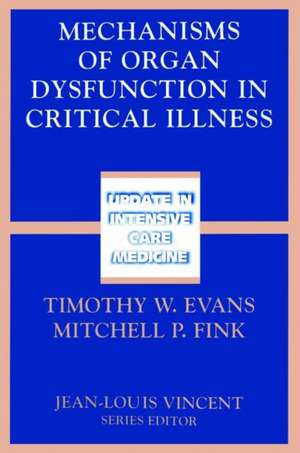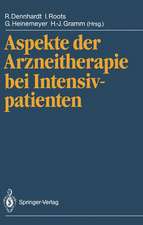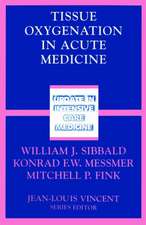Mechanisms of Organ Dysfunction in Critical Illness: Update in Intensive Care Medicine
Editat de Timothy W. Evans, Mitchell P. Finken Limba Engleză Paperback – 21 ian 2002
| Toate formatele și edițiile | Preț | Express |
|---|---|---|
| Paperback (1) | 787.02 lei 6-8 săpt. | |
| Springer Berlin, Heidelberg – 21 ian 2002 | 787.02 lei 6-8 săpt. | |
| Hardback (1) | 1108.72 lei 6-8 săpt. | |
| Springer Berlin, Heidelberg – 28 aug 2001 | 1108.72 lei 6-8 săpt. |
Preț: 787.02 lei
Preț vechi: 828.44 lei
-5% Nou
Puncte Express: 1181
Preț estimativ în valută:
150.64€ • 163.69$ • 126.62£
150.64€ • 163.69$ • 126.62£
Carte tipărită la comandă
Livrare economică 21 aprilie-05 mai
Preluare comenzi: 021 569.72.76
Specificații
ISBN-13: 9783540426929
ISBN-10: 3540426922
Pagini: 432
Ilustrații: XVI, 410 p.
Dimensiuni: 155 x 235 x 23 mm
Greutate: 0.62 kg
Ediția:Softcover reprint of the original 1st ed. 2002
Editura: Springer Berlin, Heidelberg
Colecția Springer
Seria Update in Intensive Care Medicine
Locul publicării:Berlin, Heidelberg, Germany
ISBN-10: 3540426922
Pagini: 432
Ilustrații: XVI, 410 p.
Dimensiuni: 155 x 235 x 23 mm
Greutate: 0.62 kg
Ediția:Softcover reprint of the original 1st ed. 2002
Editura: Springer Berlin, Heidelberg
Colecția Springer
Seria Update in Intensive Care Medicine
Locul publicării:Berlin, Heidelberg, Germany
Public țintă
Professional/practitionerCuprins
Mitochondrial Biology.- Cellular Responses to Hypoxia: Role of Oxidant Signal Transduction.- The Mitochondrial Permeability Transition: A ‘Pore ‘Way to Die.- Cytopathic Hypoxia in Circulatory Shock: The Role of Poly (ADP-Ribose) Synthetase Activation.- Derangements in Cellular Oxygen Metabolism.- Pharmacologic and Metabolic Mitochondrial Rescue.- Leukocytes and Cell Signaling Mechanisms in Inflammation.- Role of Leukocytes in Sepsis and Lung Injury.- Dysregulated Neutrophil Apoptosis in the Pathogenesis of Organ Injury in Critical Illness.- Does Apoptosis Play a Role in the Development of Sepsis-Induced Myocardial Dysfunction?.- The Intracellular Signaling Pathways of Inflammatory Stress.- Pro-Inflammatory Cytokines: Double-Edged Swords in the Pathogenesis of Bacterial Infection.- Organ-Organ Interactions in Multiple Organ Failure.- Microcirculatory Dysfunction.- Endothelial Cell Dysfunction and Abnormal Tissue Perfusion.- The Microcirculation in Sepsis.- Lung and Kidney.- Pulmonary Vascular Dysfunction.- Pulmonary Epithelial Injury: Clinical and Experimental Evidence for a Major Role in Acute Lung Injury and Multiple Organ Dysfunction.- Ischemia-Induced Derangements in the Actin Cytoskeleton: Mechanisms and Functional Significance.- Multiple Organ Failure and the Kidney.- Apoptosis in Renal Ischemia-Reperfusion Injury.- Gastrointestinal Tract.- Local Muscularis Inflammatory Mechanisms of Ileus.- Mechanisms Responsible for Intestinal Barrier Dysfunction in Critical Illness.- Liver Dysfunction: Nitric Oxide, Carbon Monoxide, and Reactive Oxygen Species.- Brain Injury.- Polyamine Oxidase and 3-Aminopropanal in the Pathogenesis of Cerebral Ischemia.- Key Mechanisms of Secondary Neuronal Damage After Brain Trauma.- Cerebral Ischemia: Pathophysiology andNeuroprotection.- Organ Dysfunction: Detection and Intervention.- Redistribution of Microvascular Oxygen Pressures in the Pig Intestine in Hemodilution and Sepsis.- Influence of Mechanical Ventilation on Organ Dysfunction.- Coagulation Abnormalities in Critical Illness.- Multiple Organ Failure: Clinical Syndrome.

































